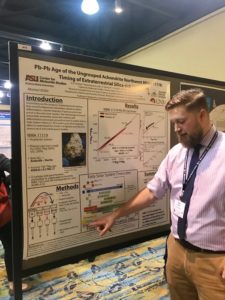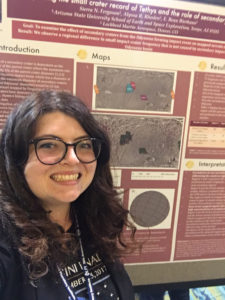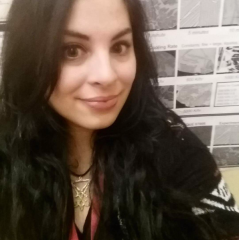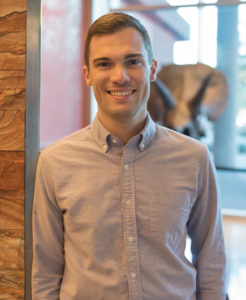Nininger student travel award recipients
The Center for Meteorite Studies and the School of Earth and Space Exploration (SESE) are pleased to announce the winners of the 2018 Nininger Student Travel Award. The goal of this award is to support travel to the annual Lunar and Planetary Science Conference (LPSC) of up to 4 SESE undergraduate and graduate students to present their latest results.
The awardees are:
Daniel Dunlap
 Daniel is a 5th year PhD candidate studying under Professor Meenakshi Wadhwa in the Isotope Cosmochemistry and Geochronology Lab at ASU. He uses both short-lived (Al-Mg and Mn-Cr) and long-lived (Pb-Pb) isotope systems to determine high precision ages of achondrites; achondrites are meteorites that have experienced varying degrees of heating which took place in the earliest epoch of Solar System history. His work specifically focuses on the ungrouped and underrepresented achondrites. By studying these achondrites, he hopes to expand our understanding of the timeline of igneous activity in the early Solar System. Read Daniel's LPSC abstract here.
Daniel is a 5th year PhD candidate studying under Professor Meenakshi Wadhwa in the Isotope Cosmochemistry and Geochronology Lab at ASU. He uses both short-lived (Al-Mg and Mn-Cr) and long-lived (Pb-Pb) isotope systems to determine high precision ages of achondrites; achondrites are meteorites that have experienced varying degrees of heating which took place in the earliest epoch of Solar System history. His work specifically focuses on the ungrouped and underrepresented achondrites. By studying these achondrites, he hopes to expand our understanding of the timeline of igneous activity in the early Solar System. Read Daniel's LPSC abstract here.
Sierra Ferguson
 Sierra is a Ph.D. student in ASU’s School of Earth and Space Exploration, working with Professor Alyssa Rhoden. Her research currently focuses on the mid-sized moons of the Saturnian system, with a focus on Tethys, Rhea, and Dione. The investigations that she is conducting on these moons involve the tectonic structures, craters, and other surface features of the moons. She utilizes ArcGIS for the mapping of these surface features on mosaics that she created from the raw Cassini image data. An overarching goal of her research is to analyze the bombardment history of Saturn’s moons to aid in the determination of the ages of the mid-sized Saturnian satellites. Read Sierra's LPSC abstract here.
Sierra is a Ph.D. student in ASU’s School of Earth and Space Exploration, working with Professor Alyssa Rhoden. Her research currently focuses on the mid-sized moons of the Saturnian system, with a focus on Tethys, Rhea, and Dione. The investigations that she is conducting on these moons involve the tectonic structures, craters, and other surface features of the moons. She utilizes ArcGIS for the mapping of these surface features on mosaics that she created from the raw Cassini image data. An overarching goal of her research is to analyze the bombardment history of Saturn’s moons to aid in the determination of the ages of the mid-sized Saturnian satellites. Read Sierra's LPSC abstract here.
Alexandra Perez
 Alexandra recently completed her M.S. studies with Professor Steve Desch in the ASU School of Earth and Space Exploration. Her research involves investigating the validity of the planetary embryo bow shock model by conducting dynamic crystallization experiments. Her results show that the most dominant chondrule texture, porphyritic, requires cooling rates < 1000 K/hr to form. The planetary embryo bow shock model therefore is a viable chondrule mechanism for the formation of most chondrules, although lower cooling rates would be preferred. Cooling rates in the bow shock model are inversely proportional to planet size, suggesting that the bow shock around a planetary embryo larger than Mars may better produce porphyritic textures. These results imply that large planetary embryos were present and on eccentric orbits during the first few million years of the Solar System’s history. Read Alexandra's LPSC abstract here.
Alexandra recently completed her M.S. studies with Professor Steve Desch in the ASU School of Earth and Space Exploration. Her research involves investigating the validity of the planetary embryo bow shock model by conducting dynamic crystallization experiments. Her results show that the most dominant chondrule texture, porphyritic, requires cooling rates < 1000 K/hr to form. The planetary embryo bow shock model therefore is a viable chondrule mechanism for the formation of most chondrules, although lower cooling rates would be preferred. Cooling rates in the bow shock model are inversely proportional to planet size, suggesting that the bow shock around a planetary embryo larger than Mars may better produce porphyritic textures. These results imply that large planetary embryos were present and on eccentric orbits during the first few million years of the Solar System’s history. Read Alexandra's LPSC abstract here.
Zachary Torrano
 Zack is a Ph.D. candidate in the Center for Meteorite Studies, studying under Professor Meenakshi Wadhwa. He studies calcium-aluminum-rich inclusions (CAIs), which were the first solids formed in the early Solar System and thus preserve a record of the earliest processes and conditions in the solar nebula. At LPSC, he presented high-precision Cr, Ti, and Mg isotope measurements of a suite of CAIs that were analyzed on the Neptune MC-ICP-MS in ASU’s Isotope Cosmochemistry and Geochronology Laboratory. These samples showed resolvable mass-independent anomalies in both Ti and Cr isotopes, suggesting significant isotopic heterogeneity in the broader CAI-forming region in the protoplanetary disk. The "bulk" Al-Mg isochron yields a canonical 26Al/27Al value, consistent with homogeneous distribution of 26Al in the solar nebula. Read Zack's LPSC abstract here.
Zack is a Ph.D. candidate in the Center for Meteorite Studies, studying under Professor Meenakshi Wadhwa. He studies calcium-aluminum-rich inclusions (CAIs), which were the first solids formed in the early Solar System and thus preserve a record of the earliest processes and conditions in the solar nebula. At LPSC, he presented high-precision Cr, Ti, and Mg isotope measurements of a suite of CAIs that were analyzed on the Neptune MC-ICP-MS in ASU’s Isotope Cosmochemistry and Geochronology Laboratory. These samples showed resolvable mass-independent anomalies in both Ti and Cr isotopes, suggesting significant isotopic heterogeneity in the broader CAI-forming region in the protoplanetary disk. The "bulk" Al-Mg isochron yields a canonical 26Al/27Al value, consistent with homogeneous distribution of 26Al in the solar nebula. Read Zack's LPSC abstract here.